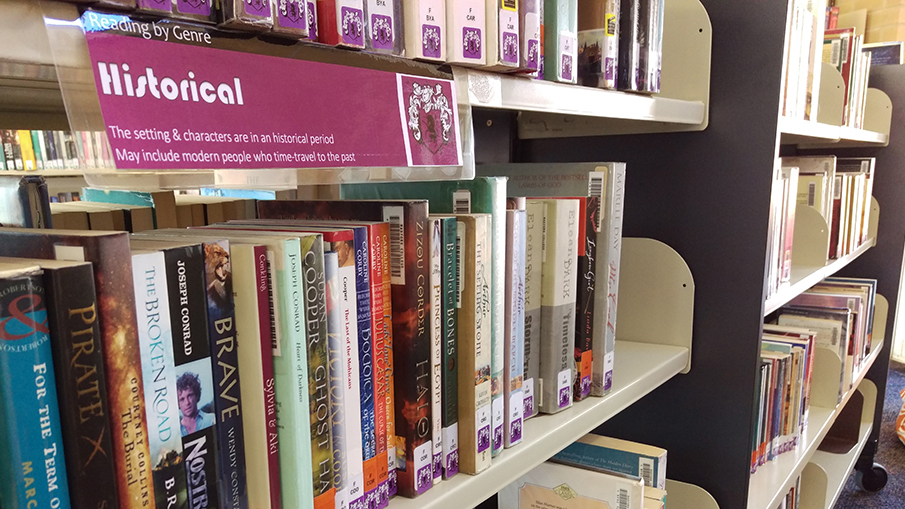Issue 104
Term 1 2018
Genre wars
Teacher librarian Martin Gray shares the results of his school library survey, looking at the different ways schools are promoting genre within their fiction collections.

My local public library has moved to sorting its fiction collection by genre and has reported a 20 per cent increase in borrowing. Naturally, this has interested the school libraries in town. I decided to run a poll to see whether making the change was worth it for our school.
Twenty-six per cent of the 100 respondents had changed to this method. Eighteen respondents were thinking about changing to genre. The rest were happy with what they had. Of those who had changed to genre order, their results were largely positive. Only two said stocktaking was harder, and three that shelving or cataloguing was harder.
Two respondents reported little or no increase in borrowing. All the others had increases of at least five per cent. One school even had an increase of more than 50 per cent. Only one library had changed from genre order back to sorting by author name, and one more was thinking of doing so.
Advantages of genre order
Several schools changed to genre order after students kept asking for books by genre. This is how bookshops are often set up and seemed to reflect what the students wanted. Respondents who had genrefied their fiction collection stated that teachers and students reported back positively. The change had increased lending figures, consequently increasing student reading.
When books are sorted by genre, students who are taking reading classes tend to find their books and settle into reading more quickly, improving lesson effectiveness.
Some literature suggests that traditional library set-ups make it difficult for many students to find books, causing them to have negative associations with libraries and book searching. It has been argued that genrefication is a way to overcome this (Potter 2016).
Advantages of name order
The argument that several survey respondents put forward for continuing to use name order for their fiction collection was that they were trying to encourage students to use search skills, especially since university libraries do not sort by genre. This would also enable students to transfer these search skills to other spheres of later life. Many of the respondents were also worried that shelving by genre would limit a student’s reading range, as they would not make discoveries outside their favoured genre. Another argument was that genres often overlap, and that ordering books in this way could be arbitrary and even self-defeating. It is also possible that students who search using the enquiry terminal would have more difficulty finding fiction books as they are not in alphabetical order (Dunne 2015).
Other survey respondents were worried that genrefication may just be a trend and, sooner or later, the library would have to change back. They also pointed to the lack of clear research indicating that it is worth the change. Reports of school and public libraries returning to traditional cataloguing for their fiction collection shows that genre collections do indeed have some issues.
Some survey respondents reported that time, space, staff allocation and money may affect a library’s ability to do a major rework of their collection. Many were simply happy with their library as is.
Some alternatives
One alternative to complete genrefication is the use of genre displays. With this approach, books are kept in name order but, periodically, a genre group is broken out into a display. Another alternative is to use spine stickers to make the genre easier to find within a collection sorted by author name.
I would like to try both of these alternatives. If they work, I will consult with the school community to see if they like it. If we do wish to change, then the genre stickers will already be in place and the transition will be much smoother. This process will be made easier by SCIS records now including genre headings.
A few questions
If a library can afford to move to sorting by genre, and we assume that increased borrowing and reading does actually occur, there are still factors to be considered before we can judge the change worthwhile:
- Are search skills affected?
- Is reading range reduced?
- If search skills or reading range are affected, would this be more or less important than increased reading?
- How much of an increase in reading is worth all the time that it would take to move to genre order?
The answers to these questions will need to be decided within each school. A selective school that has a high level of reading may want to focus on search skills. A school with poor reading statistics may wish to do anything to get those figures up. There is no clear and obvious choice.
References
Dunne, K 2015, ‘Genrefication of the fiction collection in an elementary school library’, Masters thesis, University of Central Missouri.
Potter JM 2016, ‘The effects of genrefication of fiction on the book selection process in elementary schools’, Culminating projects in information media, paper 7.
